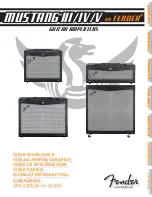Page 7
Showing a probe reading 1
st
output valve
Replacing the KT88/EL34 Valves
Important: Do not attempt to change the KT88/EL34
without reading these notes. Failure to do so could
be both dangerous and damaging to the amplifier.
When replacing valves, it is essential that you use a
“matched quad”.
Health & safety; High voltages are present inside the
amplifier and on exposed valve sockets when valves
are removed, so take suitable care. It is not
necessary to remove the bottom cover. Beware
valves get hot in operation!
5, Changing valves: You should if possible check the
bias setting before you attempt to change the valve(s), in
order to familiarise your self with the procedure.
The safe way is to change and check one or two valves
at a time. Remove the first old valve and fit the
replacement. Switch on and measure bias, you should
be setting the reading for each valve to about 350mv (0.,
Do not allow the reading to go above -800mv. Don’t
worry how low the reading goes this will not cause
damage. Continue in the same way and fit all four
valves. Do final adjustment when the amplifier is fully
warmed up.
If all is well there should be no more than a barely
detectable hum from the speakers, and the amplifier
should sound OK When tested.
6, If you cannot set up the 400/450mv then the valve is
probably faulty or is unsuitable.
If the valves are brand new, you will need to check again
after approximately 10 & 100 hours, after that only
occasionally or if you suspect a problem.
NOTE: If you are changing to a different type of
valve, be ready to change the bias quickly, as the
setting from say KT88 to EL34 may be quite large.
7, To avoid damage to the amplifier and electric
shock hazard you must use only valves marked
KT88/EL34 (or 6550), 6SL7, 6SN7 Or that you know to
be direct equivalents.
Use only valves which you know
to be new or good condition and test the amplifier
thoroughly before resuming normal use.
8, Replacing the small valves:
6SL7 (centre) and 6SN7 valves.
Neither of these
requires any set up procedure. It’s just ‘plug and play’,
although care should be taken when removing and
inserting not to break the centre spigot. (These valves
are similar with the same pin connection; accidental
wrong insertion would not cause damage).
Icon Audio are happy to check the valves/amp or
your re-bias your amp free of charge.
9, 274B Rectifier. This should normally last
longer than the audio valves. Replacements may
be obtained from Icon Audio. Alternative valves
to use are GZ34, 5AR4, GU5.
*
RMS watts
Do not literally exist! But this figure is based upon the RMS
voltage output (V²/R).
*Push Pull
is a very elegant way of virtually cancelling out non linear
distortion, noise and hum. Whilst dramatically increasing the power and
damping factor. In Class AB about 1/4 of the output is pure class A. Unlike
transistor designs there is NO crossover distortion before the amplifier
reaches full output.
*Ultralinear
(or Distributed Load). This is a true “win-win” output stage
design. Having virtually the all the characteristics and low distortion of pure
Triode valves, whilst keeping 90% of the power of pure Pentodes types.
*
The Leak Stereo 20
(& 50/60) series used a single ECC83 triode first
stage coupled to an ECC83 double triode “long tailed pair” phase splitter.
Originally developed by A D Blumlein in the 1930’s. This design was also
widely used by GEC, Mullard, Sugden etc. However the “TL+” series used
an EF86 Pentode, now widely regarded as having an inferior sound).
*Power output
level will vary from 25 watts (6L6) up to 45 watts (KT88)
depending upon the output valve type.
7 Specification & Features
(Typical conditions @ 240v 50Hz)
•
KT88/EL34 output valves or eqv (6550)
•
6SL7 double triodes for first stage
•
6SN7 double triodes phase-splitter
•
274B full wave rectifier
•
No
feedback
used
•
Custom hand wound transformers with Tertiary
winding.
•
Hand wired point to point components
•
No printed circuit board
•
No
tag board
•
Ceramic valve bases for low noise/leakage
•
HT delay circuit to protect cathodes (optional)
•
40w RMS per channel Ultralinear
•
20w RMS per channel Triode mode
•
Signal to noise level -90db
•
Freq response better than 20-20kHz +0-1db
•
Power bandwidth 10hz-30khz
•
0.15% THD at full output
•
4 and 8 ohms output taps
•
Valve
rectifier
•
Choke regulated power supply
•
Supplied with attractive safety guard
•
Audiophile quality metal film resistors
•
Audiophile quality polypropylene audio caps
•
Japanese ‘Blue’ ALPS volume pot.
•
Rubicon/Nichichron
power
caps.
•
Internal wiring using Teflon silver cable
•
Valves carefully matched for best performance
•
Gold plated Input & speaker terminals
•
Inputs for CD, Tape, Tuner, Aux
•
Tape monitor
•
250mv sensitivity for full output
•
230/240volts, 76w SB, 140w Min, 240watts max
•
1.6 amp AS rear fuse (with spare)
•
390W, 210H, 410D Amp overall 25kg
•
Carton= 34x51x49cm 28kg packed
•
IEC mains lead, (5amp fused)
•
Conforms to CE ROHS and WEEE where applicable
Specification subject to change without notice.


















